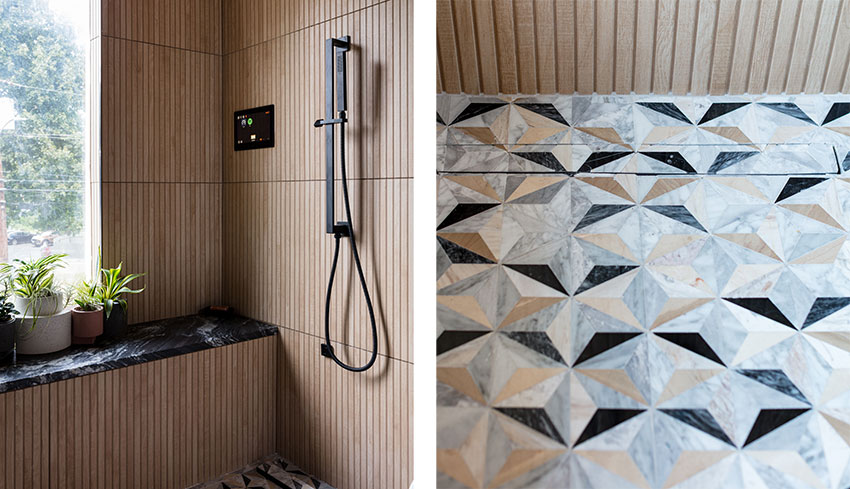
Photo courtesy of Infinity Drain
Architectural linear drains help make a visual design statement while also providing the water drainage, safety, and hygiene needed in many different building locations, indoors and out.
Draining water away from buildings is a fundamental need in most projects. This is true for indoor and outdoor locations as well as many different building types. However, just because there is a functional need doesn’t mean that the solution can’t also be a design feature. Architectural linear drains have been used to achieve both – effective drainage and design feature excellence. Many architects are paying closer attention to the quality of the drainage products and specifying architectural drains instead of commodity solutions. This is particularly true where higher amenities are concerned such as outdoor areas, wellness spaces, wet rooms, balconies, etc. where high-end appearance is required but so is compliance with performance requirements such as effective drainage and accessibility. In this course, we address some of the basic principles and criteria for incorporating architectural drainage and show examples of successful solutions.
OVERVIEW OF DRAINAGE SYSTEMS
In the design and construction of buildings and sites, it is always important to consider how water is being drained and carried away from areas where it may be accumulating in an unwanted manner. Failure to properly drain such accumulated water can lead to cosmetic damage at best or structural damage at worst to buildings, landscapes, or other areas. That typically means that drainage systems are installed in floors, balconies, terraces, pool surrounds, kitchens, or any other location where water is expected to be present on the floor or walking surface. Of course, finished drain systems are usually identified by a grille or grate that is visible on top of the drainage channel and piping components. In some cases, a purely functional and utilitarian drain cover may be called for, but in many locations, there is a desire to have the drains and their grates blend with a higher level of design.
To be sure that the look of the space being drained is not compromised, the selection of appropriate architectural drains and their integration into an overall scheme is paramount. That means the shape of the drain, the depth of the drain channel, the material and design pattern for the grate, and other factors all come into play. These items aren’t just for mechanical and plumbing engineers to consider; rather, they require the review, input, and collaborative decision-making process of architects, landscape architects, and interior designers. Only in this way is the total design able to meet the aesthetic and performance needs of the project.
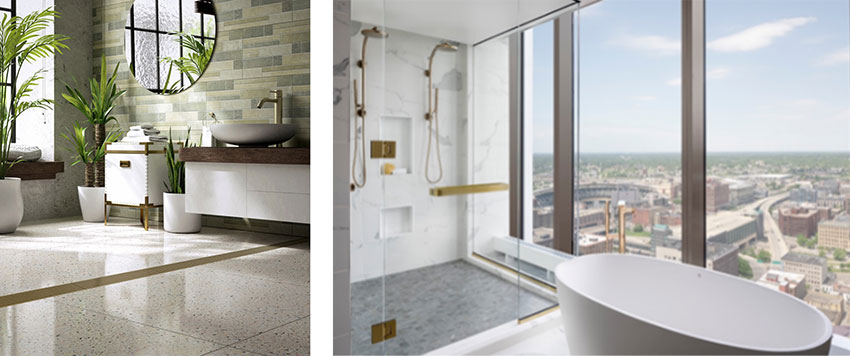
Photos courtesy of Infinity Drain
Architectural linear drains can make a specific design statement or blend into a surrounding design at the discretion of the project’s architect or interior designer.
User Considerations
The presence of water in or around a building can be a welcoming and inviting feature such as for a pool, a pleasant bath area, or on a covered outdoor space in gentle rainfall. The assumption in all of these cases, however, is that people are unharmed in any way, which usually means that excess water needs to be drained away from the water feature area. In that regard, there are three things to consider during the design of spaces with water.
- Safety: Where there is water on the floor or another walking surface, there can be an accident waiting to happen. Safety is an issue on wet surfaces since they are more slippery than dry ones and can cause people walking on them to slip, fall, and injure themselves. Therefore, the design intent of a proper drainage system needs to include the long-term, ongoing removal of excess water and the safety hazards that it may entail. Additionally, it is important that the drain installation be designed and carried out such that the drain is flush with the adjacent finish materials. This requires proper detailing to allow for the correct depth of the recess for the channel and the drainage grate, all to avoid any tripping hazard. The surface of the grate also needs to be considered to be sure it does not have holes or openings that are too large such that a heel or toe could get stuck.
- Hygiene: Water that doesn’t drain can become a breeding ground for bacteria and mold. This is a recognized health issue in buildings since either one can cause adverse reactions and even disease in people who spend time in the “wet” spaces. Wet areas can interact with building materials too as a contributor to mold growth or as a factor in the deterioration of those materials. That can cause more dirt, bacteria, germs, and other non-hygienic matter to build up and exasperate conditions. Therefore, in addition to keeping other building components drier, it is important that any drainage system can be readily and easily cleaned as needed. This is the best way to be sure that any growth is eliminated but also to be sure that any foreign objects or debris that may enter can be removed.
- ADA and Barrier-Free Accessibility: Most commercial buildings need to address accessibility as a key design feature. The relevant accessibility codes and standards address paths of travel and the floor surfaces along those paths, typically indicating that surfaces need to be smooth and flat – no more than ½ inch difference in height between the floor and anything else that needs to be wheeled over (i.e., door thresholds, shower entries, etc.). This design consideration applies to floor drains too; the grate on them needs to be recessed such that no more than ½ inch is protruding above the surface – in fact, fully flush is better. This approach is commonly used whether to meet code and ADA requirements or simply because it is a building owner’s desire to accommodate a current or future need for accessibility.
There can be other factors that affect people in buildings related to floor drains, including the general appearance and wellness features associated with the spaces they serve. At a minimum, however, the three priorities of safety, hygiene, and accessibility usually come into play in a well-designed building or outdoor space.
Drainage Types
As with most building products and systems, there are choices available to incorporate into design and construction. Some of those choices use standard components, and others incorporate specialty items or components with custom design features and options. Generically, there are three fundamental types of floor drains discussed as follows.
- Architectural Linear Drains: From a design perspective, this type of drain can work most elegantly with the layout of a space. It is premised on the slight sloping of a floor or other surface such that any water drains to the selected side.
Then, along the length of the low end of the surface, a linear floor drain is installed in a recessed manner to drain away the water. In this case, the drain catchment area (also called a channel assembly) is long and rectangular with either a vertical or horizontal drain outlet. That drain outlet can be connected in an appropriate manner to suitable drain piping that is located within the floor assembly or outdoor surface system. The drain channel assembly is covered with a long, rectangular grate that functions to allow water to enter while keeping out debris and providing a safe surface for people to walk.
- Center Drains: These are probably what many people think of when considering the use of a floor drain. In this case, a floor area, whether for a room, a shower, or an outdoor surface, is gently sloped from each side to a low point in the center. The drain catchment is connected to a suitably sized drainpipe that carries the collected water away from the area to its appropriate destination (i.e., sewer, storm drain, retention pond, etc.). The catchment mechanism is typically covered with a square or round grate that allows water to enter but keeps out other things such as debris. The cover also provides the needed safety protection for people such that their foot lands on a smooth, flat surface instead of dropping into the open area of the catchment. Center drains such as this are available in standard sizes to suit different conditions.
- Custom Drain Solutions: In some cases, neither linear drains nor center drains are the right architectural solution. For those situations, it is good to be aware that custom drains are possible. They can take the form of curved or circular drains around a similarly shaped surface where water needs to be captured and redirected. Or they can be rectilinear by connecting several linear drains to suit the geometry of a space. There are many different options and configurations possible, but as with any custom solution, it is best to check with a manufacturer during project design to determine fabrication parameters and tolerances that are possible and factors that influence cost. For example, a custom drain can address unique performance requirements such as the percent of open or free area of the top grate or a larger outlet diameter that may be required in geographic areas that receive higher levels of precipitation. Custom drain grates can also be designed to address certain load requirements that may be in place for outdoor drains such as heavy cleaning or maintenance equipment around a pool.
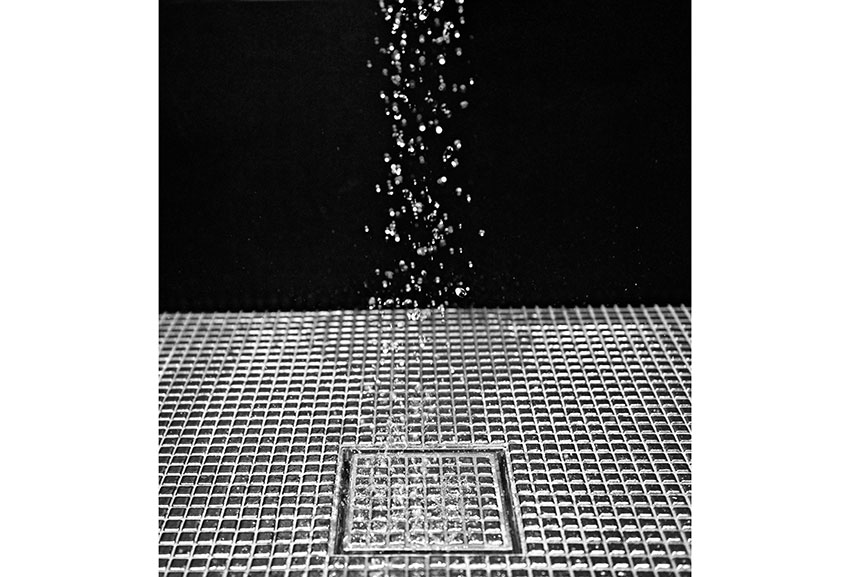
Photos courtesy of Infinity Drain
Center drains can accommodate a wide range of floor surfaces, including the ability to work with small-sized tiles as shown here.
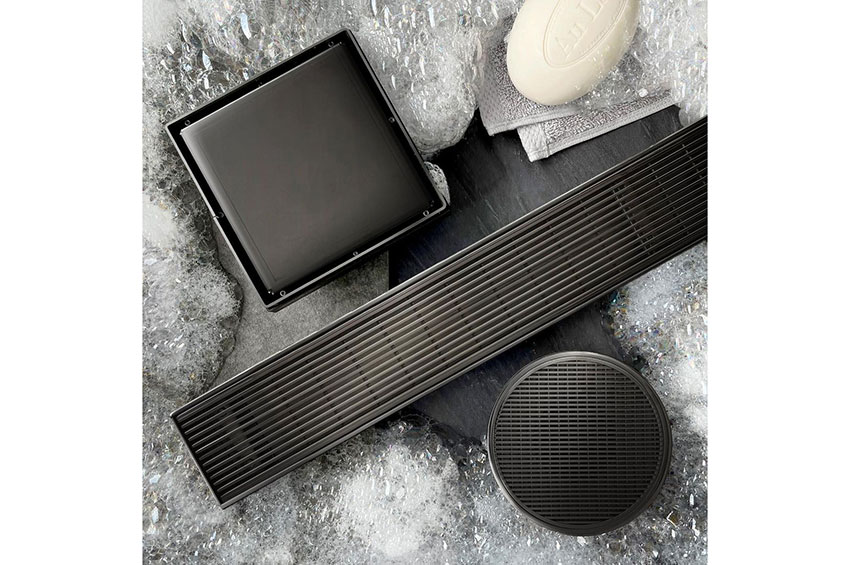
Photo courtesy of Infinity Drain
Customized drain solutions are most suitable for highly personalized designed spaces or special conditions which warrant it.
LINEAR DRAIN DESIGN CONSIDERATIONS
When considering architectural linear drains, the first image that comes to mind is the portion of the system that is visible – the grate or cover on the floor. Does it look basic and functional, or does it enhance the overall design? The answer comes from having products available that can either complement the rest of the surrounding design or blend in completely to provide a continuous visual element. This may be done with standard products that are finished in a variety of offerings, customizable with inserts on site, or through the use of personalized fabrications. The key is to work with a manufacturer who provides options for different sizes, appearances, finishes, etc. that can work with an overall architectural design.
Design Trends
Designers should be aware of current trends to respond to requests from clients, building owners, and users. Here are some current trends that relate to spaces where architectural linear drains are commonly used.
- Elevated Design: Bathrooms, in particular, have become spaces where functionality meets quiet luxury. Emphasizing the fusion of utility and elegance, quiet luxury requires high-quality details that have a timeless appeal. Linear drains, with the possibility of inserting tiles to match the surrounding floor, exemplify this trend by simply blending into their surroundings and disappearing from view. This subtlety allows designers to craft thoughtful spaces that transform into personal oases. Quiet luxury also relies on continuity of visual elements, such as wall-to-wall linear drains or those that are flush against floors. Typically, linear drains are located on one end of a space and are not recommended for the center of a shower or similar area. Center drains designed specifically for that purpose are better suited there.
- Customization of Finishes: The visible part of the drainage system is the exposed grate or covering. To elevate the design of the spaces where the drains are located, manufacturers are offering a full range of standard finishes and the ability to meet current needs with custom options. Current trends for hardware and fixtures tend to feature softened metallics like brushed or champagne gold, which introduce warmth and help ground modern environments. Similarly, pastel colors continue to make headway by evoking nostalgia and serve as an antidote to anxiety and fast-paced lifestyles. Manufacturers offer many personalized options, including custom finishes, which allow consumers, designers, and architects the flexibility to make creative, stunning choices. At least one manufacturer has even worked directly with architectural firm Gensler to have them design new products for general use as well as their own projects.
- Accessible Showers: Many people prefer the ability to walk in or roll in (if needed) to a shower without a curb or other encumbrance. This is evident in many hospitality locations as well as residences of all types. Size-adjustable architectural linear drain products have been providing this capability for quite some time. This choice offers an elegant aesthetic and enhances safety and accessibility for all. As more owners and users request this capability, the use of these kinds of linear drains will likely continue to grow.
For an overall insight on the design aspects of these products, Jonathan Brill, founder and CEO of Infinity Drain, says, “Normally people think of architectural drainage as something utilitarian, something you have to have, and it gets put in without much thought. We often get the comment, ‘Wow, I never really thought of the drain before… until we saw one that was beautiful.’ That’s what makes architectural drains that unique, yet vital detail that elevates the spaces they are specified for.”

Photo courtesy of Infinity Drain
The finish and appearance of architectural linear drains can be selected and matched to current design trends in different building conditions.
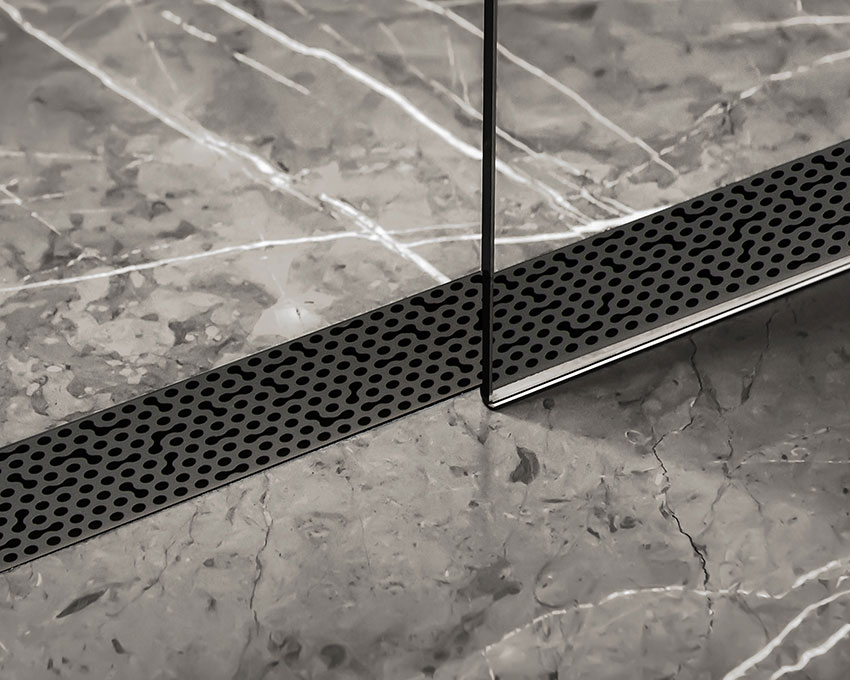
Photo courtesy of Infinity Drain
The visible grates of architectural linear drains are available in a variety of patterns and colors, plus some that are designed to “disappear” into the surrounding floor surface by using tile inserts along a wall edge.
PERFORMANCE CONSIDERATIONS
The performance of any type of drain product will depend both on the drain construction and its manner of operation. These attributes are both part of the system that isn’t typically seen but is critical to perform properly.
All drains have a capacity of how much water can be drained over a given amount of time (i.e., gallons per minute). The drain piping is usually sized by a consulting engineer to match the needs of the area being drained based on a calculated volume and rate of water being managed. In the same way, any drainage system, particularly the channel, must be assessed for the capacity of the water it can receive and drain over time. If the channel is too large compared to the piping, there is a risk of water pooling at the drain since water is captured faster than it can be drained away. If the channel is too small, water may pool outside of the drain because the system cannot adequately capture all the water present. For linear drains, the size of the drain is not just the length, but also the depth of the channel which can vary. Therefore, for the best drainage performance, water flow calculations need to be considered for anything that is not a small or typical drainage condition such as a bathroom shower. Outdoor drainage designs, in particular, should be addressed in this way since an abundance of rainwater can overwhelm any drainage solution.
Keeping the above in mind, we can turn our attention to some of the particular details of architectural linear drains.
Channel Assembly/Catchment
This component is the working part of the drain that is concealed below the grate and fabricated to first catch then direct the water to the drainpipe. It is the part that needs to be designed into the floor or surface so that it provides the needed solution and is integrated as a flush, finished condition. Commonly, the channel assembly is made from stainless steel, but some PVC channels are also available. There are several general types from which to select.
- Site-Sizable Installations consist of modular linear drain components that can be cut to fit on site or joined together to span any length. The outlet for this type can be located anywhere along the channel run. It is available in kit lengths or as a set of components in both stainless steel and PVC. Site-sizable installations can use traditional waterproofing methods.
- Fixed-Length Installations are prefabricated to specific lengths to be installed directly into the on-site construction. They include pre-pitched channels with a set outlet location. Both standard kit sizes and custom fabrication are available. Made from stainless steel, they are also intended to be installed with traditional waterproofing methods.
- Fixed-Flange Installations are used when a vertical outlet is used for direct connection to the drain piping. They include a pre-pitched flanged channel with set outlet location. Standard kit sizes or custom fabrication are available, all made from stainless steel. This type should only be installed with liquid membrane or fabric sheet waterproofing methods.
- Side Outlet Installations are used where a vertical outlet is not practical. They include a pre-pitched flanged channel with a set outlet location and horizontal (side) outlet. Standard kit sizes or custom fabrication are available in stainless steel. As with fixed flange installations, side outlet channels should only be installed with liquid membrane or fabric sheet waterproofing methods.
The height of channel assemblies ranges from 1” to 1-5/8.” The lower profile 1” channel height makes barrier-free installation easier in some cases. Such reduced height channels are likely to be reinforced on the sides with extra grooves or flanges to provide increased stability in mortar-set installations.
Grate Styles
Typically, the grates or covers are fabricated out of metal, most often from different types of stainless steel. The thickness of the steel can vary from 18 gauge down to 7 gauge to suit different project weight-bearing conditions. The final appearance can vary based on the selection of the pattern of openings (linear grate, holes, etc.) and the final color of the finished metal. In this way, the drain grate can either blend into the floor surface to be less noticeable or be used to create a contrasting line that works toward a purpose in the overall design.
If the desire is to have the cover blend into the surrounding surface and visually disappear, there are options to have a linear opening on either side of a central section that is designed to receive finishing material or tile that matches the surroundings. Hence, the linear drain takes on the same appearance as the surrounding floor or outdoor surface. If complete obscurity is sought, there is also the option of using a recessed reveal slot drain such that the flooring extends over the flange of the channel and allows the water to enter into the channel via a 3/8-inch reveal in the surface of the floor. A small, removable panel allows the channel and drain line to be accessed in this case. Because of these different approaches, it is easy to see why linear architectural drains offer an elegant and coordinated look for architects and designers to create well-designed, elegant spaces without the visual interruption of the grates or covers. Most of the covers are standardized by manufacturers and have likely already been tested for safety, but if there is any concern, a review of any safety testing should be done.
Waterproofing
Depending on the application, there may be a need to provide a waterproofing material or membrane around the drain channel, just as with any surface that is exposed to water. This is important to keep the water where it needs to be and not seeping elsewhere, both for safety and hygiene. The type of waterproofing can vary depending on the type of drain and compatibility with the material of the channel assembly. The key is to integrate drain components with a waterproofing membrane in a way that is also compatible with the surrounding floor construction.

Images courtesy of Infinity Drain
Waterproofing membranes that are pre-applied to architectural drains are available such that they can provide added protection against water leakage.
In response to this critical need, at least one manufacturer offers linear drain products that utilize a double waterproofing method combined with a factory-applied waterproof membrane fabric. It is readily compatible with traditional waterproofing methods like vinyl, lead/copper pan, or hot mop underneath, allowing the bonded fabric method to function as the first line of defense above. This saves installers time on the job. It also provides some assurance of performance since both the drain manufacturer’s and membrane manufacturer’s warranties apply.
Other Considerations
There are a few other things that can come into play when making design decisions about architectural drainage systems. As noted earlier, there are prefabricated sloped metal pans available that can streamline the installation of a sloped floor and drainage system. The size and slope options should be verified with a manufacturer, but in some cases, using this available product can mean less construction time and cost than traditional installations of flooring and deck surfaces. Manufacturers should be consulted for lead times on different products, particularly if customization is needed. Generally speaking, fast turnaround times are possible but always subject to change.
LINEAR DRAINS IN BUILDING APPLICATIONS
With an understanding of the principles and aspects of architectural linear drains, we can now focus on different types of building applications and project examples.
Commercial Building Applications
Commercial buildings are often high-use areas that require durability and accessibility. At the same time, the interior design of these buildings often needs to be high quality to be consistent with the image or appearance that the building owner or tenant is seeking to convey. Further, it needs to preserve that quality over time by being easy to clean and maintain.
Residential Building Applications
Residential projects may not need to be quite as heavy-duty as commercial ones, but clients and owners still seek higher levels of design and quality. In some ways, these projects, whether single-family or multifamily, can be more personal and fully customizable. This is true not only for aesthetic design but for functional design too. There has been a growing interest in residential design that allows for “aging in place” as a desirable long-term feature, thus increasing the significance of accessibility as residents grow older.
Indoor Applications
There are many interior locations besides bathrooms that can be logical places to use architectural drains. The general versatility of these products means they can be used anywhere. Some typical examples include commercial kitchens, laundry rooms, indoor pools, spa areas, locker rooms, exercise rooms, and other places where water may need to be drained away discreetly but effectively. A sometimes-overlooked place is an elevator pit which typically needs integral drainage. It can be equally important to include architectural linear drains in front of elevator doors. That way, if the fire sprinklers are activated, the sprinkler water can be collected and drained away, keeping it out of the elevator shaft and allowing first responders to function unencumbered.
Outdoor Application
Outdoor spaces often need to drain away rainwater, snow melt, irrigation water, or excess swimming pool water. That means that outdoor locations such as terraces, pool areas, balconies, and decks may all benefit from architectural linear drains. The same is true for paths of travel for pedestrians and/or vehicles.
CONCLUSION
Specifying architectural linear drains in a building project can provide appealing, well-performing solutions for many different applications. Successful design begins by understanding the nature and type of architectural drains available, including the options for design and performance characteristics. Then, all of the areas that require drainage can be assessed for sizing and type, including indoor and outdoor spaces. The combination of design and performance makes for successful drainage solutions in different building types and settings. It is abundantly clear that architectural linear drainage systems provide a design option that improves the overall, integrated appearance of drains while still meeting all of the needed code, performance, safety, and operational needs of different types of projects.
Peter J. Arsenault, FAIA, NCARB, LEED AP is a nationally known architect and a prolific author advancing safer buildings by design. www.pjaarch.com, www.linkedin.com/in/pjaarch


